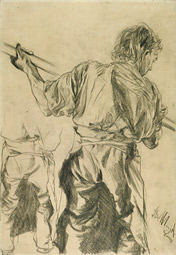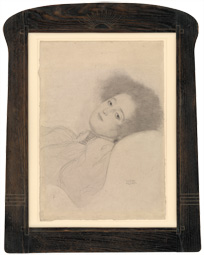 |
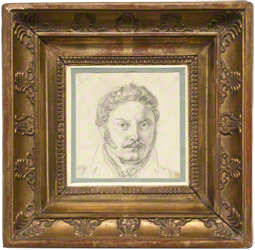
 |
 |
Portrait of Peder Hjort, Carl Barth, about 1818–19
|
 |
 |
|
Introducing recent acquisitions that represent a new area of the J. Paul Getty Museum's collection, this exhibition features German and Austrian drawings made between 1770 and 1900. During that period, the Germanic world underwent profound changes—intellectual, social, economic, and political. Events such as the publications of Johann Wolfgang von Goethe, the Industrial Revolution, the formal unification of Germany into a nation state, and the invention of psychoanalysis shaped modern life and its representations in art.
In the early 1800s, the philosopher Georg Wilhelm Hegel professed that art was a fundamental mode of consciousness whereby humans could reach a profound understanding both of themselves and the world. Art, therefore, reflected the spirit of the age ("Zeitgeist" in German) in which it was created; this influential notion held sway over the 19th century. In fact, drawing—along with music—proved to be an essential expression of the period. It achieved an extremely high rank among the pictorial arts, sustained by the rise of art academies, which particularly emphasized draftsmanship as part of artistic training and practice.
The portrait above reflects the emotional sincerity and faithfulness to nature sought by the Nazarenes, a group of Germanic artists who worked primarily in Rome. Artist Carl Barth created this intimate likeness (less than four inches high without its frame) to commemorate his friendship with the influential Danish writer and art critic Peder Hjort. He used silvery strokes of graphite to render the sitter's eyes, hair, and features in microscopic detail.
|
 |
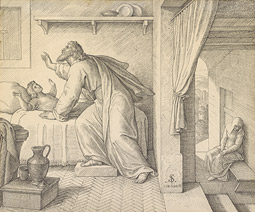
 |
 |
Elijah Revives the Son of the Widow of Zarephath, Julius Schnorr von Carolsfeld, 1842
|
 |
 |
In the 1800s, art academies assumed prominence in Germany and Austria for the training of young artists. The strict academic regimen, which focused on the study of the human figure, did not allow artists to express much of their individual temperaments. As a result, some of the most talented artists preferred to venture into new aesthetic directions, bringing fresh approaches to the depiction of myth, history, and daily life.
Julius Schnorr von Carolsfeld was associated with the Nazarenes, a group established in 1809 as a breakaway from the Vienna Academy. Its members moved to Rome, where they shared a communal life in search of artistic renewal and spiritual purity—hence their great interest in religious subjects. Stylistically, the Nazarenes favored a strong linearity. They influenced an enormous number of German artists well into the second half of the 19th century.
This drawing illustrates a passage from the Old Testament, when the prophet Elijah implores God to heal a widow's child. The widow prays in the background while in the foreground the child extends both arms, miraculously coming back to life as God answers Elijah's plea.
The drawing is a study for The Bible in Pictures (published in Dresden in 1852–60), Schnorr von Carolsfeld's most famous work, which included 240 woodcut illustrations and took him some 40 years to complete. This drawing is admirable for its rigorous economy of line and masterful manipulation of light and shade.
|
 |
 |

 |
 |
Spring Has Arrived, Ludwig Richter, 1870
|
 |
 |
|
An illustration for a family picture book, this highly finished watercolor celebrates the arrival
of spring. Budding trees, nesting birds, children with newborn lambs, ducklings—all signify the
promise of renewal that accompanies the new season. The fading of winter is symbolized by the
seated crone.
With the increasing sense of national pride and the development of mass publishing, Ludwig Richter's fairy-tale illustrations made him a cultural hero for the German people before and after the unification of Germany in 1871.
|
 |
|
Adolf von Menzel, the most renowned German painter and draftsman of the second half of the 19th century, adopted a radical approach toward the objective depiction of reality. While preparing
his most iconic painting, The Iron Rolling Mill, he made numerous detailed pencil studies at a factory in eastern Germany. Here he depicted two rear views of an industrial worker whose attention is focused on the task at hand.
Menzel sought to capture the humanity of his subject, rather than magnify the gigantic technological achievements of the Industrial Revolution.
|
 |
|
In this sensitive portrait by Gustav Klimt, a young woman, her face haloed by a cloud of hair, reclines on a chaise longue and gazes languidly at the viewer. Klimt's loose treatment of the sitter's clothing and chair focuses our attention on her expression, highlighting the emotional connection between sitter and artist.
This drawing marks a major turning point in the evolution of Klimt's style. Its soft-focus handling and dreamlike atmosphere became key elements of the art of the Vienna Secession, the avant-garde movement he helped to found in 1897. Rejecting conservative attitudes toward the arts, the Secession searched for new forms of expression that would be in keeping with modern life.
The drawing is housed in a frame designed by the Wiener Werkstätte (Viennese Workshops), a group of artists with links to the Secession.
|
 |

 |
 |
View of Dresden, Christian Gottlieb Hammer, 1810
|
 |
 |
|
|
 |
|
|
 |
Berlin, Dresden, Munich, and Vienna were the most vibrant cultural centers of the Germanic world, each with a lively artistic tradition and a strong identity. But none could claim to be either dominant or nationally representative as could Paris and London in their respective lands.
With its grand scale (nearly 30 inches wide) and astonishing level of detail, this colorful panorama renders the unique atmosphere of Dresden, the traditional capital of Saxony (eastern Germany).
Here Christian Gottlieb Hammer focused on Dresden's historic center (destroyed during World War II) and its elegant skyline—including splendid Baroque buildings—seen from the verdant banks of the Elbe River, where figures go about their daily activities. Hand-colored prints of similar size were made after this watercolor, which was likely conceived from the outset for reproduction.
|
 |
 |
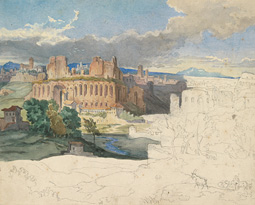
 |
 |
The Ruins of the Imperial Palaces in Rome, Carl Rottmann, about 1831
|
 |
Rome came closest to being the dominant center for Germanic artists. Indeed, many of them—including Johann Wolfgang von Goethe—were drawn to the Eternal City and, more widely, to the Italian peninsula, lured by the remains of classical antiquity and the picturesque scenery of the countryside.
"Where else can one find so many outstanding Germans in one place as right here? I almost think Rome must be considered part of Germany," noted Julius Schnorr von Carolsfeld in 1818.
This vibrant view of Rome is preparatory for a fresco of the same subject that artist Carl Rottmann executed for King Ludwig I of Bavaria as part of a cycle of 28 wall paintings of famous Italian views. These decorated an arcade at Munich's Hofgarten (Garden Court), where they were meant to evoke a journey through Italy.
As often with Rottmann's watercolors, a significant part of the image remains unfinished, which reveals his pencil underdrawing technique.
|
 |
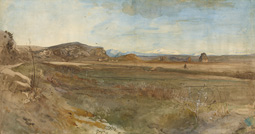
 |
 |
Landscape on the Via Flaminia, Albert Venus, 1869
|
 |
 |
A talented landscapist, Albert Venus rendered this panoramic view, which he saw on the Via Flaminia, the ancient road that linked Rome to northern Italy, cutting its way across the mountainous central region of the peninsula.
Ruins of Roman tower tombs, visible in the distance, are bathed in the soft, wintry light. Venus executed this watercolor on the spot, applying the medium with wonderful looseness and coloristic clarity. The composition is structured horizontally through contrasting tonal areas, and the whole conveys the artist's fascination with the unique atmosphere of the Italian countryside.
This landscape and others in the exhibition evoke Goethe's statement that "The highest demand made on the artist is this: that he be true to nature, that he study her, imitate her, and produce something that resembles her phenomena. How great, how vast this demand is."
|
 |



